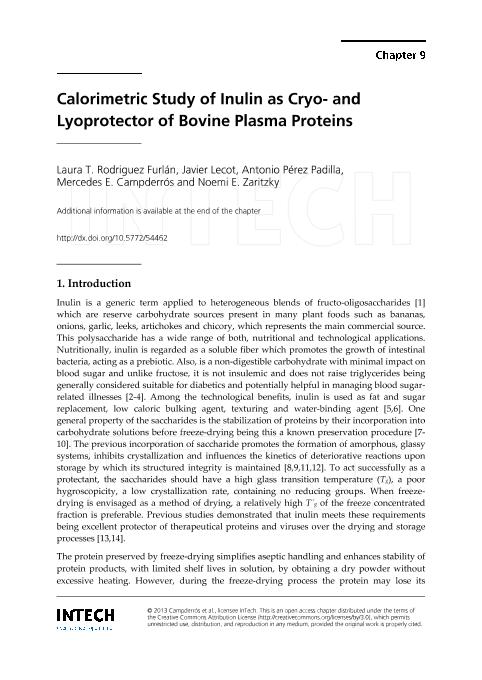Mostrar el registro sencillo del ítem
dc.contributor.author
Rodriguez Furlán, Laura Teresa

dc.contributor.author
Lecot, Carlos Javier

dc.contributor.author
Pérez Padilla, Antonio

dc.contributor.author
Campderrós, Mercedes Edith

dc.contributor.author
Zaritzky, Noemi Elisabet

dc.contributor.other
Elkordy, Amal Ali
dc.date.available
2021-12-09T11:14:08Z
dc.date.issued
2013
dc.identifier.citation
Rodriguez Furlán, Laura Teresa; Lecot, Carlos Javier; Pérez Padilla, Antonio; Campderrós, Mercedes Edith; Zaritzky, Noemi Elisabet; Calorimetric Study of Inulin as Cryo- and Lyoprotector of Bovine Plasma Proteins; IntechOpen; 2013; 197-218
dc.identifier.isbn
978-953-51-0947-1
dc.identifier.uri
http://hdl.handle.net/11336/148456
dc.description.abstract
Inulin is a generic term applied to heterogeneous blends of fructo-oligosaccharides which are reserve carbohydrate sources present in many plant foods such as bananas,onions, garlic, leeks, artichokes and chicory, which represents the main commercial source.This polysaccharide has a wide range of both, nutritional and technological applications.Nutritionally, inulin is regarded as a soluble fiber which promotes the growth of intestinalbacteria, acting as a prebiotic. Also, is a non-digestible carbohydrate with minimal impact on blood sugar and unlike fructose, it is not insulemic and does not raise triglycerides being generally considered suitable for diabetics and potentially helpful in managing blood sugarrelated illnesses . Among the technological benefits, inulin is used as fat and sugar replacement, low caloric bulking agent, texturing and water-binding agent . One general property of the saccharides is the stabilization of proteins by their incorporation into carbohydrate solutions before freeze-drying being this a known preservation procedure. The previous incorporation of saccharide promotes the formation of amorphous, glassy systems, inhibits crystallization and influences the kinetics of deteriorative reactions upon storage by which its structured integrity is maintained . To act successfully as a protectant, the saccharides should have a high glass transition temperature (Tg), a poor hygroscopicity, a low crystallization rate, containing no reducing groups. When freezedrying is envisaged as a method of drying, a relatively high T´g of the freeze concentrated fraction is preferable. Previous studies demonstrated that inulin meets these requirements being excellent protector of therapeutical proteins and viruses over the drying and storage processes .The glass transition temperatures of the maximally concentrated frozen solutions (T´g) wereanalyzed and compared to the experimental results by applying the predictive equations of Miller/Fox and Gordon/Taylor extended for multi-component systems. The glass transition (Tg) of the freeze dried multi-component mixtures, the onset crystallization temperature (Tc) of the solute at temperatures above Tg, in the freeze dried samples were determined.Furthermore, the kinetics of the denaturation and the thermal denaturation (Td) of the freeze-dried samples, at different DSC scan rates, protein concentrations and pH, were analyzed and the thermodynamic compatibility of the different matrix components were determined. The enthalpy change involved in the denaturation reactions of proteins was also determined. A kinetic model that describes bovine plasma proteins denaturation was proposed.
dc.format
application/pdf
dc.language.iso
eng
dc.publisher
IntechOpen

dc.rights
info:eu-repo/semantics/openAccess
dc.rights.uri
https://creativecommons.org/licenses/by-nc-sa/2.5/ar/
dc.subject
Inulin
dc.subject
Cryoprotector
dc.subject
Lyoprotector
dc.subject
Bovine plasma proteins
dc.subject.classification
Otras Ingeniería Química

dc.subject.classification
Ingeniería Química

dc.subject.classification
INGENIERÍAS Y TECNOLOGÍAS

dc.title
Calorimetric Study of Inulin as Cryo- and Lyoprotector of Bovine Plasma Proteins
dc.type
info:eu-repo/semantics/publishedVersion
dc.type
info:eu-repo/semantics/bookPart
dc.type
info:ar-repo/semantics/parte de libro
dc.date.updated
2020-09-02T20:18:22Z
dc.journal.pagination
197-218
dc.journal.pais
Estados Unidos

dc.description.fil
Fil: Rodriguez Furlán, Laura Teresa. Consejo Nacional de Investigaciones Científicas y Técnicas. Centro Científico Tecnológico Conicet - San Luis. Instituto de Investigaciones en Tecnología Química. Universidad Nacional de San Luis. Facultad de Química, Bioquímica y Farmacia. Instituto de Investigaciones en Tecnología Química; Argentina
dc.description.fil
Fil: Lecot, Carlos Javier. Provincia de Buenos Aires. Gobernación. Comisión de Investigaciones Científicas. Centro de Investigación y Desarrollo en Criotecnología de Alimentos. Consejo Nacional de Investigaciones Científicas y Técnicas. Centro Científico Tecnológico Conicet - La Plata. Centro de Investigación y Desarrollo en Criotecnología de Alimentos. Universidad Nacional de La Plata. Facultad de Ciencias Exactas. Centro de Investigación y Desarrollo en Criotecnología de Alimentos; Argentina
dc.description.fil
Fil: Pérez Padilla, Antonio. No especifíca;
dc.description.fil
Fil: Campderrós, Mercedes Edith. No especifíca;
dc.description.fil
Fil: Zaritzky, Noemi Elisabet. Provincia de Buenos Aires. Gobernación. Comisión de Investigaciones Científicas. Centro de Investigación y Desarrollo en Criotecnología de Alimentos. Consejo Nacional de Investigaciones Científicas y Técnicas. Centro Científico Tecnológico Conicet - La Plata. Centro de Investigación y Desarrollo en Criotecnología de Alimentos. Universidad Nacional de La Plata. Facultad de Ciencias Exactas. Centro de Investigación y Desarrollo en Criotecnología de Alimentos; Argentina
dc.relation.alternativeid
info:eu-repo/semantics/altIdentifier/url/https://www.intechopen.com/chapters/42266
dc.relation.alternativeid
info:eu-repo/semantics/altIdentifier/doi/http://dx.doi.org/10.5772/54462
dc.conicet.paginas
474
dc.source.titulo
Applications of Calorimetry in a Wide Context: Differential Scanning Calorimetry, Isothermal Titration Calorimetry and Microcalorimetry
Archivos asociados
